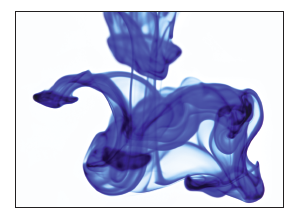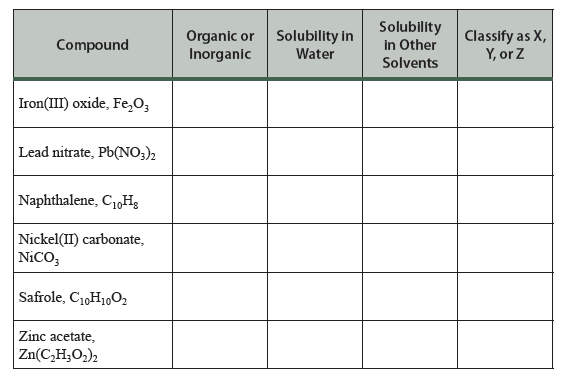Chapter 14. Separation of the Components of a Mixture
Objectives

- Use extraction methods to separate the components of a mixture and determine the mass percent of each component of the mixture.
- Learn the basic concepts of solubility (solute, solvent, insoluble, precipitate, soluble).
- Illustrate simple organic and inorganic compounds and be able to identify as such when given the chemical formula.
Introduction
Outside of the chemistry laboratory, we rarely encounter pure substances. The air we breathe is a mixture of different gases, predominantly nitrogen and oxygen. In fact, it is challenging to find examples of pure substances in our society. “Aluminum” foil, for example, is not pure aluminum but a mixture of Al and Al2O3, a “nickel” coin is 25% Ni and 75% Cu, and a “silver dollar” coin has a Mn core with an outer coating of brass that is comprised of Cu, Zn, Mn, and Ni. Mixtures with a uniform substance throughout are called homogenous, and ones with varying compositions of two or more distinct components and are called heterogeneous.
Inside the chemistry laboratory you are provided with many very pure substances, (although an extremely careful analysis would reveal that these too contain some impurities and are often mixtures). Where do pure substances come from? Usually from the separation of a mixture.
Separation of a mixture is a process that depends on a difference in a physical property of the components. In Lab 1 you investigated the property of density, and this property can be used to separate components in a mixture. During the Gold Rush a crude (but profitable) separation involving density saw a prospector swirl sand and gravel in a shallow pan. The less dense materials would wash away, leaving the denser substances (like gold!) in the bottom of the pan.
In this experiment you will separate the components of a mixture by using differences in solubility. Solubility is the amount of a substance, the solute, that will dissolve in a given amount of another substance, the solvent. Solubility is a property you are quite familiar with. Every time you dissolve sugar in a cup of tea you are “experimenting” with solubility. Other kitchen experiments involving solubility you may have tried include adding salt to oil (salt dissolves in water; does it dissolve in oil?), or adding salt to a pot of water and then boiling away the liquid (is salt left in the pot, or does it “vanish”?).
Discussion
2.1 Organic and Inorganic Compounds
The heterogeneous solids that you will be separating in this lab are comprised of inorganic and organic substances (X, Y, and Z). Organic chemistry is described as the chemistry of compounds of carbon. Organic materials contain carbon and hydrogen atoms that are usually combined with other non-metals like nitrogen and oxygen. Inorganic materials refer to non-organic substances, though it is possible to have carbon atoms in inorganic materials like carbonates (CO32−) and cyanides (CN−). You will see organic compounds from time to time throughout general chemistry and this lab, but there are also entire courses dedicated to the study of organic chemistry. You should be able to look at a chemical formula and determine if it is organic or inorganic. In this lab course the organic waste and inorganic waste produced are always disposed of separately.
Question 2.1: Identify the following compounds as organic or inorganic:

The separation for this lab will be achieved by using the differences in solubility among the components. Solubility will be discussed more in-depth later in the course, but we encounter this property regularly. We know that salt will dissolve in water and sugar will dissolve in our coffee and tea to make homogeneous solutions. Contrarily, we also know that oil will not mix with water and the two will remain separated in a heterogeneous solution. Solubility is greater when the solute and solvent are more alike. The organic component X will tend to dissolve in organic solvents, and the inorganic component Y will tend to dissolve in water or other similar solvents. Most metal carbonates are insoluble, that is to say they do not dissolve readily in most solvents, including water (and these are designated as component “Z”). Researchers have extensively studied the solubility of many compounds, and this data is compiled in the CRC Handbook of Chemistry and Physics for us to reference. Organic components (designated “X” in this experiment) tend to dissolve in organic solvents, and inorganic components (designated “Y”) tend to dissolve in water or other similar solvents.
Use the CRC Handbook of Chemistry and Physics, available online. Information will be found in either the table of “Physical Constants on Inorganic Compounds” or “Physical Constants of Organic Compounds.” This may also be available in print form at the Science and Engineering Library.

2.2 Separating a Heterogeneous Mixture
Addition of the organic solvent dichloromethane to the mixture will dissolve the organic compound, X. The process of dissolving a compound out of a mixture is called extraction. The solvent containing the soluble component—in this case the organic compound X— must then be removed from the remaining solid.

On a large scale this would be accomplished by filtration. On a semimicro scale—quantities that we are using—the separation is achieved by centrifuging and decanting. A centrifuge is a mechanical device that rotates test tubes causing the solid, more dense, component of the mixture to quickly gravitate to the bottom of the test tube. The liquid may then be poured off, or decanted, to separate the two. This process is shown below.

Once the solid and liquid are separated, the next component may be removed by the same process but by now using water as the solvent. The water-soluble inorganic component Y is removed in this process, leaving the water-insoluble component Z.
Question 2.2: Choose a solvent that will separate each of the following pairs and state which compound will dissolve and which will remain solid.
- Fe2O3 and Pb(NO3)2
- Fe2O3 and safrole (C10H10O2)
- Pb(NO3)2 and naphthalene (C10H8)
A flowchart is commonly used to show chemical separations and summarizes the procedure. The flowchart for this lab is shown below.

Materials Required
Equipment
- 4-mL test tube
- glass wool
- watch glasses
- crucible and cover
- 10-mL graduate cylinder
- micro stirring rod
- micropipet
- test tube holder
- Bunsen burner
- thin-walled rubber tubing
- ring stand, ring, clay triangle
Chemicals
- dichloromethane, CH2Cl2
- distilled water, H2O
- unknown sample
Common Equipment
- analytical balances
- centrifuge
Cautions
Dichloromethane is a suspect carcinogen. Be careful to avoid burns from the ring, triangle and the open flame. Fume hoods must be on.
Procedure
Answer questions in your lab notebook as you go along. Discussions with your peers and TAs are encouraged.
- Weigh a 4-mL test tube.
Question 2.3: Which balance should you use: top-loading or analytical?
- Place a plug of glass wool in the open end of the test tube and reweigh. Remove the plug and set it aside on a small watch glass.
- Add approximately 0.6 g of sample to the test tube and reweigh.
- Weigh a large watch glass on the same balance used in step 1.
- Weigh a crucible and cover on the same balance used in step 1.
- Add approximately 2 mL of dichloromethane to the test tube (fill about halfway) containing the sample and stir for 2 minutes to dissolve the organic component. Centrifuge the test tube for 30 seconds and use a micropipet to remove the decantate (the liquid above the solid). Dispense the decantate into the weighed large watch glass. Be careful not to remove and solid with the decantate or to spill the liquid.
Question 2.4: At this point in the lab you have a test tube with solid and a watch glass with liquid. Which contain the components Y and Z? Where is component X? Hint: The flowchart may be helpful.
- To ensure that all of the organic component has been separated, wash the sample with dichloromethane, as you did in step 6, two more times. Set the watch glass at the front of your hood so that the solvent will evaporate while you continue with the rest of the experiment.
- When the solvent has completely evaporated, weigh the watch glass containing the solid organic component, X.
- To the sample in the test tube (components Y and Z), add approximately 2 mL of water to the test tube (fill about halfway) and stir for two minutes to dissolve the soluble inorganic component, Y. Centrifuge the test tube for 30 seconds and use a micropipet to remove the decantate. Dispense the decantate into the weighed crucible. Again, be careful not to remove any solid.
Question 2.5: Which component is now in the decantate?
- To ensure that all of component Y has been separated, wash the sample with distilled water, as you did in step 9, two more times.
- Place the crucible on a clay triangle, ring, and ring stand. Put the cover on the crucible, leaving a small gap to let steam escape. Heat gently to evaporate the water. Heating too rapidly will cause spattering and loss of sample. (See Appendix D for use of the gas burner.)
- When the water has all evaporated, allow crucible, cover, and soluble inorganic component, Y, to cool before weighing.
- The solid remaining in the test tube is the insoluble metal carbonate, component Z. Replace the glass wool plug and heat the test tube gently over a low oxygen flame to dry the solid. If heated too strongly, the carbonate will decompose. Cool to room temperature.
- Weigh the test tube containing solid carbonate, Z, with the glass wool in place.
Waste Disposal
Dissolve the solid organic component in 5 mL of CH2Cl2 and place in the organic solvents beaker. The water-soluble inorganic component can be rinsed down the sink. Dispose of the insoluble inorganic compound in the metal salts beaker. The waste disposal sheets must be properly filled in. Your lab instructor will dispose of the total volumes in the appropriate containers.